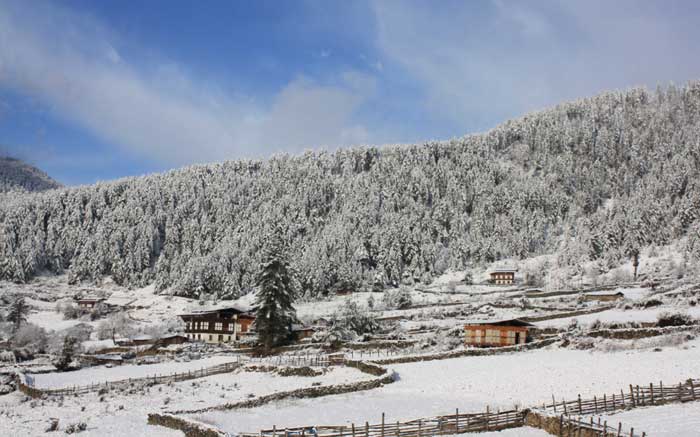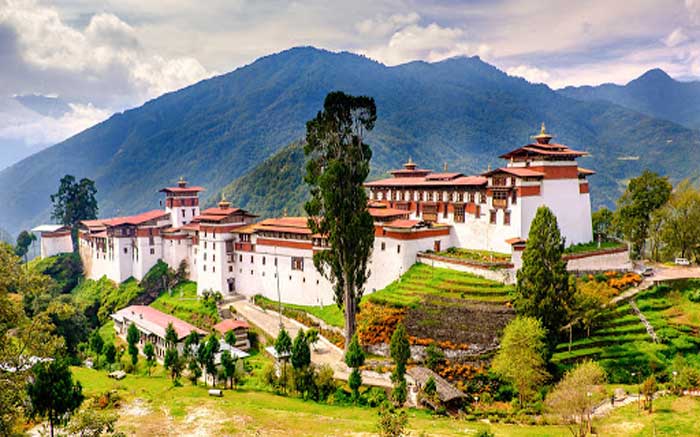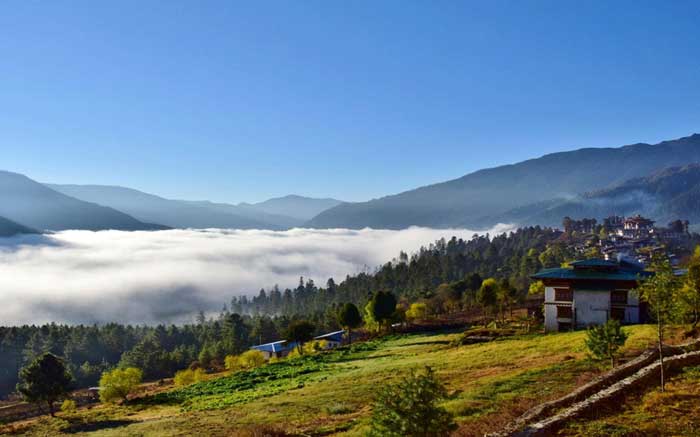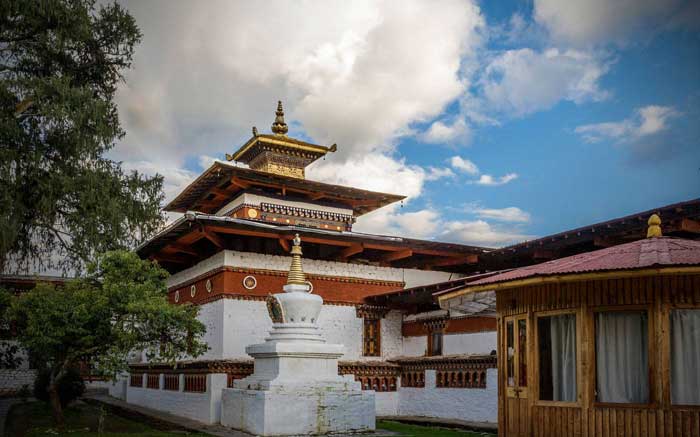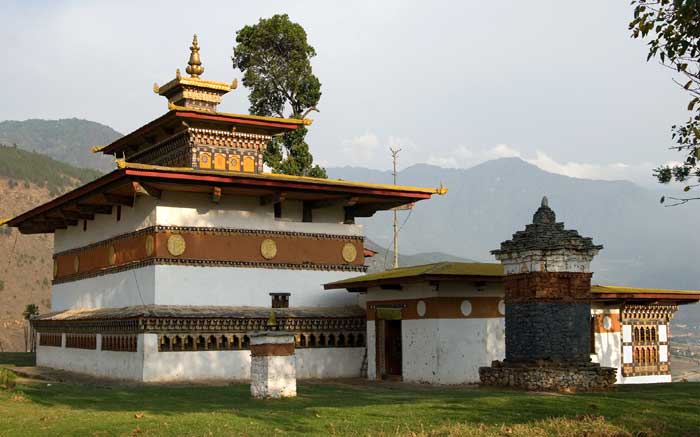-
Day 1
Arrive Paro International Airport
During the flight, on a clear day, you can see breathtaking views of the Himalaya Mountains, including the sacred Jumolhari and Jichu Drake peaks in Bhutan. Thimphu (2,320m), the capital city of Bhutan. On the way to Thimphu, on the opposite side of the river, you will see a temple owned by the descendants of Dubthob Thangtong Gyalpo (iron bridge builder). He was responsible for building numerous iron bridges throughout Bhutan. After lunch visit some of the capital's attractions, according to the group's interests or have your own time to explore the town. Check in hotel & local sightseeing: Afternoon: Half day Sightseeing of Thimphu. Overnight in Thimphu.
-
Day 2
Thimphu sightseeing After breakfast drive to Thimphu the capital city of Bhutan
King's Memorial Chorten (Monument)
Chang Gangkha Monastery (one of the oldest monastery in the valley)
National Zoo (contains national animal takin)
Folk Heritage Museum and the Textile Museum
Budha Point
School of Arts and Crafts (also known as the painting school)
Traditional Paper Factory (made from Daphne plant) Thimphu week end market.
Overnight in Thimphu
-
Day 3
Thimphu short hike
After breakfast, travel to the base camp of Tango Monastery and hike up to the Monastery. Tango is the center for higher studies for monks. The hike up will take approximately 45 minutes. The view from Tango Monastery is breathtaking. Drive back to Thimphu and evening free to relax / stroll around Thimphu town. Overnight at hotel in Thimphu.
-
Day 4
Thimphu - Wangduephodrang (afternoon Punakha sightseeing) (3-hour drive)
After breakfast you will drive to Wangduephodrang, with a stop en route for tea at Dochu La (3,100 meters), where on a clear day you can get spectacular views of the Himalayas. After lunch you will drive to Punakha, the former capital of Bhutan, and visit Punakha Dzong, which is noteworthy both for being one of the most beautiful dzongs in Bhutan and also for having been built by the first Shabdrung in 1637. On the way back from Punakha, you will stop at Metshina Village and take a 20-minute walk through the rice fields to Chimi Lakhang, which is a fertility temple. Overnight in Punakha .
-
Day 5
Punakha – Wangduphodrang – Trongsa - Bumthang
After breakfast you will drive to drive to Trongsa via Pele la pass at an altitude of 3,150 metres, a wonderful opportunity for photographs. Commanding the Mangde Chu at an altitude of 2,200 metres Trongsa Dzong is the most impressive dzong in Bhutan. Built in 1644 by the Shabdrung, the dzong is an architectural masterpiece. After lunch, travel to Bumthang, the religious heartland of the nation, with lush valleys and hilly forests. Bumthang consists of four valleys--Chumey, Choekhar, Tang, and Ura--with altitudes varying from 2,600 to 4,000 meters. Overnight at hotel in Bumthang Jakar.
-
Day 6
Bumthang Sightseeing
Jambay Lhakhang, built in the 7th century by the King Songtsen Goempo of Tibet. In his effort to propagate Buddhism he had a plan to build a total of 108 temples in Tibet and neighboring kingdoms.
Chakhar Lhakhang. Besides the main road, a short distance beyond Jambay Temple is Chakhar (Iron Castle) Lhakhang. Although it is easy to mistake it for a house and drive right by, this is an interesting temple and is worth a short visit. It is one of the 108 monasteries built by him to subdue evil spirits in the Himalayan region.
Kujey Lhakhang (Kujey means, "Body imprint"). The temple to the right is the oldest and was built by Minjur Tempa in 1652. It was built around the cave in which Guru Rimpoche meditated and left his body imprint.
Tamshing Lhakhang. This temple is also known as Tamshing Lhendrup Chholing (Temple of the Good Message).
Jakar Dzong, "castle of the white bird". According to legend, when the lamas assembled in about 1549 to select a site for a monastery, a big white bird rose suddenly in the air and settled on a spur of a hill. This was interpreted as an important omen, and the hill was chosen as the site for a monastery and for Jakar Dzong. The fortress is now used as an administrative center of the valley and summer residence of Trongsa monks.
In the evening stroll around the beautiful landscape of the Bumthang Jakar valley. Dinner and overnight in Bumthang.
-
Day 7
Bumthang –Gangtey
After breakfast, travel to Gangtey Gompa. Visit Gangtey Gompa, which now houses one of the only Nyingmapa monastery in Bhutan. The valley is also the winter home to the rare black-necked cranes (Grus Nicorocolis), which migrate, from remote parts of Tibet, China and Siberia during winter to this valley. Drive Overnight at Gangtey.
-
Day 8
Gangtey-Thimphu - Distance: 71 km Estimated driving time: 2 1/2 hrs
After breakfast, walk to Khamsum Yuelley Namgyal Chorten (50 Mins) temple built by the Queen Of Bhutan for peace and stability in this ever-changing world. Travel back to Thimphu, visiting Simtokha Dzong en route. This dzong, built in 1627, is the oldest in Bhutan. It now houses the Institute for Language and Culture Studies. In the evening,drive to see the Takin Zoo, which houses the national animal the Takin that is only found in Bhutan. Drive further upto Sangaygang to get a bird’s eye view of the Thimphu valley in the evening. Dinner and overnight at a hotel in Thimphu.
-
Day 9
Thimphu – Paro
After breakfast, we will drive towards Paro (approx 1.20 hours drive). On arrival at Paro (should reach latest by 8.30 am), visit the Ta Dzong, a circular fortress that once protected this valley from the Tibetan invasion. It is now the National Museum with an excellent collection of Bhutanese antiquities. A short drive back to the Paro Rinpung Dzong which was built and consecrated in 1646 by Shabdrung Ngawang Namgyal. This Dzong is also the administrative seat of the district of Paro and it also contains a state monastic community of about 200 members.After lunch, will drive up to visit Drugyel Dzong which is located upstream to the end of the paved road. This Dzong was also built by Shabdrung Ngawang Namgyel in 1647 to commemorate his victory over the Tibetans in 1644. In fine weather the Mount Jumolhari, 7314 meters or 24000 feet high, appears as a back drop. This mountain which marks the frontier with Tibet, is sacred ,as are all the mountains in Bhutan and it is the dwelling place for Goddess Jhomo. This mountain was never climbed till the submit and it is now a protected peak. In 1951 the Dzong was caught in a terrible fire started by a butter lamp which fell over the altar and Drugyel Dzong became no more than a dramatic silhouette falling into ruins. While coming back from Drugyel Dzong & Kitchu monastery. The evening ends with a walk through the Paro's main shopping district. The local shops sell a variety of goods-groceries, textiles as well as prayer flags. We will then return to the hotel. Overnight at Paro.
-
Day 10
Paro
After early breakfast, take a ride to road end at the base of Taktshang (Tiger Nest) and start gradual ascent towards Taktshang about 2 hrs of hike to Temple. Tiger nest is one of the most sacred temple for Buddhist which was founded by a Great Indian Buddhist master known under the name of Guru Padmashambhava, who was born as a eight year old boy from the blue lotus in a lake at Danakosha, During eight century this great master arrived here in Takshang riding on the flying tigress in the form of Drojidroley (fierce thunderbolt) subsequently meditate here for about three month and subdued many evil spirits.This temple hang on the face of sheer cliff about 900 m above the PARO valley, the view from the temple courtyard is spectacular. Walk back to road point and take a ride to town . Evening Stroll in Paro Town. O/N in Paro.
-
Day 11
Paro Chelela Pass (an hour drive)
Enjoy the drive and the scenic vistas from Chelela Pass (3,988 mts.), among the highest motor able roads in Bhutan. After coming back from Chelela lunch and after you will be taken for most important places like the one of the oldest Dzong, Drugyel Dzong & Kitchu monastery. Over night in Paro.
-
Day 12
Morning departure from Paro Airport

